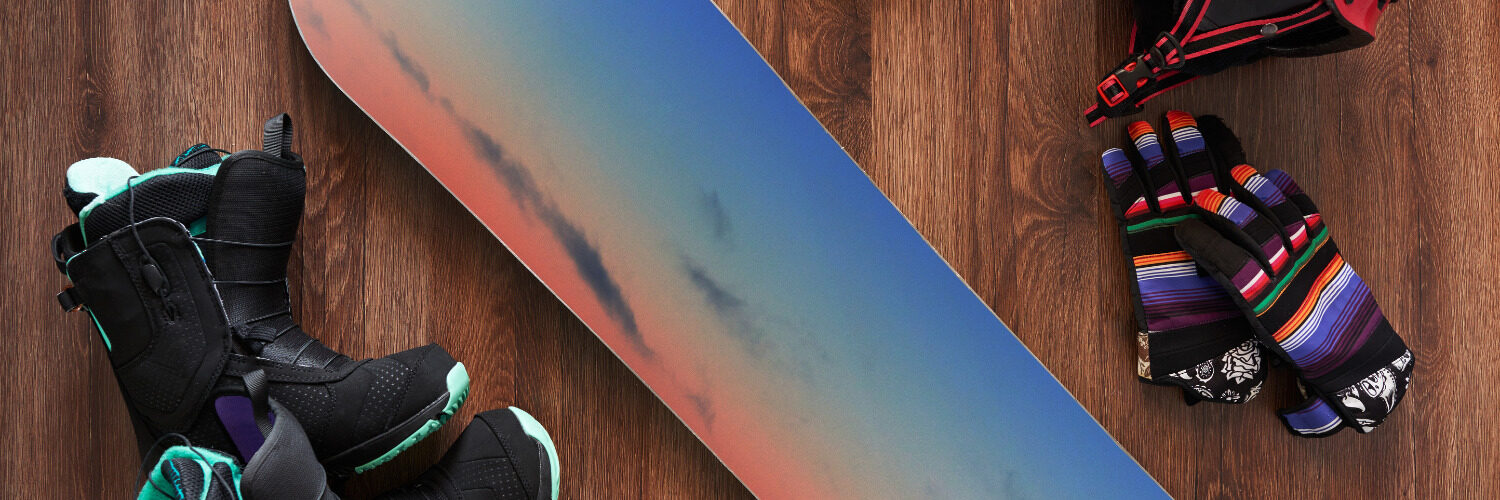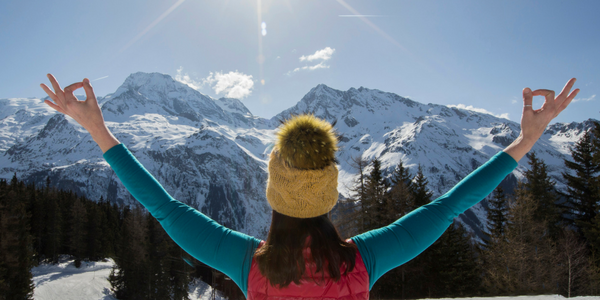

Yoga for Snowboarding | Adventure Yogi
Snowboarding and Yoga couldn’t be more opposite, more yin and yang. However, they complement each other in many ways.
Snowboarding is fast and furious, the thrill-seeking adrenaline sport that gets you up early in the morning for a day on the mountain, wild with excitement and anticipation of how the day of powder hounding is going to turn out. The thrill of throwing yourself down the mountain, discovering new places to go, gliding through powder or dodging your way through a tree run, searching for that ultimate line is so exhilarating. Remembering to look up and being overwhelmed by the raw, natural beauty and power of the mountains before you. There is something meditative within this experience, the mind clears, all worries fall away and you are left with just you and the mountains. It is an incredibly spiritual feeling that creates a sense of being present and the freedom to just be. So, how do we bring the two together to help improve your snowboarding experience?
Yoga for the slopes
Yoga in comparison is calm and soothing, a meditative practice controlled through the breath and inner focus, yet it has a similar effect on the mind. Allowing the space to be present in body and mind, yoga can be just like snowboarding. Luckily, Yoga benefits snowboarding in many ways, not only by helping to focus the mind and keep calm in difficult situations; it develops muscle strength, flexibility and improve your balance – allowing you to recover more quickly. The movement and positions required in yoga can elevate your snowboarding and help reduce the physical demands put on the body by the sport. Yoga helps to stretch out the muscles that boarding strengthens yet at the same time shortens. Quads, gluteal muscles and calves need lengthening due to the static positioning on the board. The strengthening of these muscle groups also causes tightness to the lower back, hamstrings and hip flexors.
Mindfulness in yoga comes from arriving at each pose and holding it, focusing on the breath to ease the body into position and calm the mind, being present in each movement which is how we should deal with snowboarding. Bring the mindfulness of your yoga practice into every move you make on your board and you will lower the risk of injury and assist with full-body awareness. So let’s hit the mat.
Strengthening the legs
It is important to focus on equally strengthening and stretching all muscle groups in the legs, otherwise, the knee joint ends up taking the strain, which can lead to serious injury around the knee. The quadriceps become overdeveloped when snowboarding and this, in turn, tightens and shortens the hamstrings. Inner thigh muscles can be shortened and tightened. In time, this can strain the knee joint by limiting the range of motion. It is important to lengthen all four sides of the upper leg, hamstrings and quads, inner thigh (adductors) and outer thigh, to minimise the strain on surrounding joints.
Distribution of weight over the board
Any snowboarder will tell you that the sport can be hard on the body because you are not completely symmetrical. This is how we aim to be. Bring awareness of how to stand on the board at all times. Notice when you find yourself over-rotating and bring your stance back into equilibrium. Simply, distributing your body weight correctly makes all the difference. When riding on the piste, distribute more weight on your front leg and when riding powder more weight on the back. Yoga for snowboarders is a great way to get to know the balance of weight foot to foot, toe to heel. Practise on dry land and you will feel more confident on the slopes!
Core and hip stability
The pelvis is the largest bony structure in the body and it houses and protects our internal organs. This is also the base of the main energetic channel in the body called the Sushumna Nadi. Often, when we learn to initiate movement from here we become naturally efficient and graceful. Hip flexor muscles are very important in maximising agility in when you’re on the snowboard. However, these muscles are rarely used day to day.
We sit to eat, sleep, relax, work and drive; whereas our ancestors were outdoor hunters and gatherers, using their bodies continuously, giving strength and force to their muscles. This is why our largest muscles are around the hip area. Building more strength and flexibility in the hips, enables a broader base of equilibrium and muscle foundation. This, in turn, improves the support to our upper body. Hip flexors also help with angulations of a turn, which means helping a boarder to make sharper, cleaner lines by being more in control of the board. Powerful and flexible hips encourage balance and good turning habits. Otherwise, boarders end up jerking their upper body to initiate a turn instead of using the lower body. Over time, this can lead to upper back pain from this awkward movement. Yoga for snowboarding helps create strength and stability where you need it!
Core
Snowboarding is a very dynamic sport. Engaging the core muscles also enhances good turns on the slopes. Furthermore, it alleviates pressure from the knees, protecting the joints from injury. Strengthening the core muscles helps to improve balance that is essential for the sport. With practice, you can redirect weight bearing that often falls onto the knees. Awareness of your centre allows you to initiate movement. This helps you turn more efficiently and distribute weight more evenly making each move less strenuous on the whole body. Core strength also offers support in falls and supports the spine in bending and twisting and stabilising. Yoga for snowboarding is an amazing way to strengthen and get to know that deep core strength. If the core isn’t engaged properly, tightness resonates in the hamstrings and hip flexors. Soon, the lower back starts to be put under strain and can create an injury.
Our Favourite Yoga Poses for Snowboarders
Incorporating these yoga poses into your snowboarding routine not only enhances your physical performance but also fosters a deeper connection with the mountains and yourself and will improve your snowboarding skills. Regular yoga practice will keep you agile and prepare your body for the snow filled adventures.
Mountain Pose: Begin your practice by grounding yourself in Mountain Pose. Stand with your feet hip-width apart, grounding firmly into the earth. Engage your core, lengthen your spine, and roll your shoulders back. This pose cultivates stability and alignment, essential for maintaining balance and coordination on the board.
Warrior II: Warrior II strengthens the legs, opens the hips, helps you improve focus and balance – qualities crucial for navigating uneven terrain on the mountain. From a standing position, step your feet wide apart, extend your arms parallel to the ground, and bend your front knee over the ankle. Gaze over your front hand, channeling the warrior within you!
Chair Pose: Chair Pose builds endurance in the legs, hips and glutes and activates the core muscles, mimicking the crouched position often adopted during snowboarding. Stand with your feet together, bend your knees, and sweep your arms overhead, palms facing each other. Sink your hips back as if sitting in an imaginary chair, keeping your chest lifted and gaze forward.
Tree Pose: Balance is key in snowboarding, and Tree Pose helps cultivate better balance, stability and concentration. Begin in Mountain Pose, then shift your weight onto one foot as you lift the opposite foot to the inner thigh or calm (avoiding the knee). Press your foot into your thigh and your thigh into your foot, finding a steady focal point to maintain balance. Reach your arms overhead or keep them at your heart centre, like branches reaching towards the sky.
Downward-Facing Dog: This is a dynamic pose that stretches the entire body, particularly the hamstrings, calves and shoulders – areas prone to tightness after a day on the slopes. Start on your hands and knees, then lift your hips towards the ceiling, straightening your arms and legs to form an inverted V shape. Ground firmly through your hands and feet while lengthening your spine.
Cobra Pose: Snowboarding engages the lower back muscles, and Cobra Pose helps counteract any tension and fatigue. Lie on your stomach with your hands under your shoulders, elbows hugging your ribcage. Inhale as you life your chest off the mat, keeping your shoulders relaxed and your gaze forward. This gentle backbend promotes flexibility and relieves stiffness in the spine – stretching every muscle in your body.
Child’s Pose: After a busy day on the slopes, grab your mat and wind down with Child’s Pose to relax and rejuvenate tired muscles. Kneel on the mat, then sit back on your heels as you extend your arms forward and lower your forehead to the ground. Surrender to the pose, focusing on deep, rhythmic breaths to release tensions and restore calmness to both body and mind.
We hope that these tips have made you feel ready to hit the slopes! Check out our website and see which one of our many ski and yoga retreats appeals to your inner AdventureYogi!


